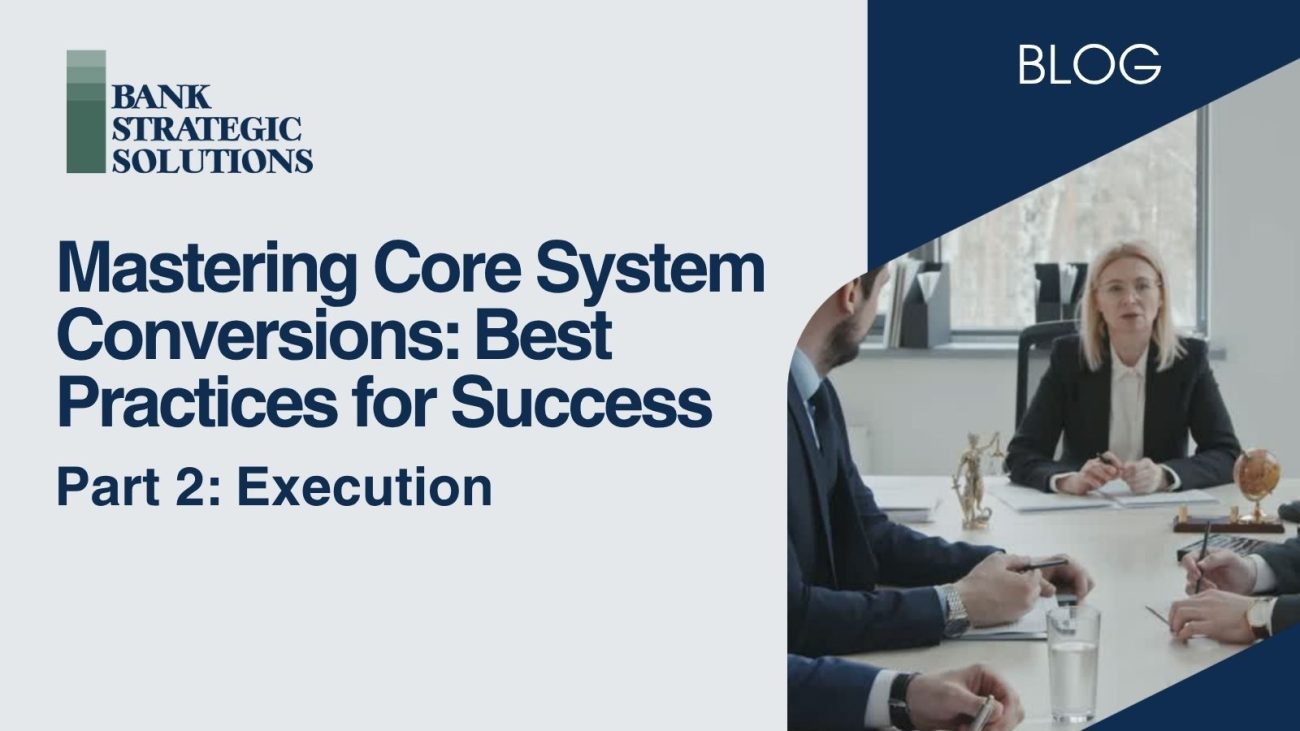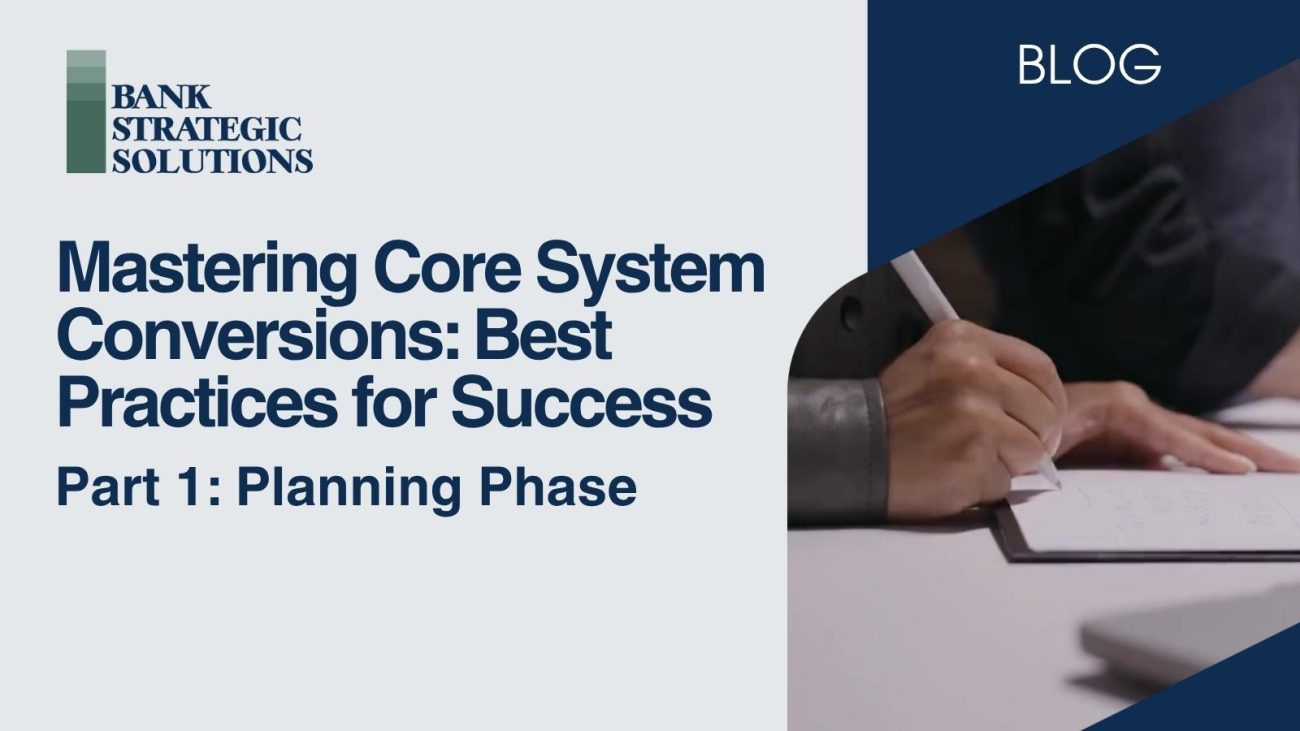Mastering Core System Conversions: Best Practices for Success
Part 1: Planning PhaseA core system conversion is one of the most complex and consequential undertakings banks can face. It’s not just a technology switch; it’s a complete transformation that impacts operations,…

Whether upgrading legacy systems or switching to a more agile core banking platform, financial institutions must approach a core conversion with meticulous planning and stakeholder alignment. Poor execution can lead to customer attrition, compliance failures, and operational disruptions. On the other hand, a well-executed conversion can unlock efficiencies, enable innovation, and set the stage for long-term growth.
From our team’s experience of more than 350 conversions, here are best practices for mastering a core system conversion, backed by insights from other industry leaders and research.
A well-executed conversion can unlock efficiencies, enable innovation, and set the stage for long-term growth.
1. Start with Business Need and Strategic Clarity (Game Plan)
Every successful conversion begins with a well-defined strategic rationale. What business goals is the bank trying to achieve? Whether the aim is digital transformation, cost reduction, regulatory flexibility, or improved analytics, clarity is essential from day one.
Best Practice: Document strategic goals and communicate them broadly. Align the core selection and implementation process with measurable business outcomes.
2. Prioritize the Customer Experience
Conversions can be disruptive to customers if not properly managed. Changes in online banking platforms, delays in transaction posting, or errors in account histories can lead to dissatisfaction and customer attrition.
Best Practice: Communicate early and often with customers. Use email, SMS, website banners, and branch signage to inform them of changes and support resources. Banks should also be prepared with post-conversion communication, as there will always be customers who were not prepared. Ongoing communication will help avoid a crisis.
3. Involve the Right Stakeholders Early
Core conversions are not IT projects; they involve and impact everyone in the organization. Involving cross-functional stakeholders early helps ensure requirements are fully scoped and user needs are reflected in system design.
Best Practice: Create a project governance framework that includes executive sponsors, operational leads, IT leaders, frontline staff, marketing, and risk/compliance. This not only improves decision-making but also drives organizational buy-in.
4. Current Process vs Future State
Skipping this step is common but always leads to issues mid-conversion cycle. Know how your current system operates, document existing process workflows including manual workarounds, and identify opportunities for automation. This will ensure that you select a core that best addresses the desired outcomes and keeps the team on track and within budget throughout the project.
Best Practice: Document current process workflows including vendor add-ins, desired business requirements and identify any gaps. Identify which systems are you retaining, and where new technologies will improve or automate current processes. Development of an enterprise-wide technology solution diagram provides a visual representation of the future state.
5. Communication & Project Governance
We have multiple communication pathways in our banks today. A unified communication plan for raising issues and tracking progress, along with a centralized location for all project materials, dashboards and schedules keeps the team informed. Auditors and examiners will request these artifacts.
Best Practice: Determine how information will be shared cross-functionally and what team member is responsible for oversight. This may include an Intranet or SharePoint site used as a document repository and, it may include utilization of project management software.
6. Vet Your Vendor
Selecting the right core provider is perhaps the most critical decision in the process. The most expensive technology investment is not necessarily the one that will deliver the desired results. Beyond system functionality, institutions must evaluate a vendor’s long-term viability, support and service model, minimized core customization, recurring release schedules, and commitment to innovation.
Best Practice: Go beyond the sales demo. Leverage your documented business requirements as a benchmark for core system selection. Do your homework on the vendor. Speak to references, obtain access to user groups, review the vendor’s implementation track record, and confirm alignment on timelines, data migration, and customization needs.
Final Thought
Core system conversions represent pivotal moments in a bank’s evolution. While the technical complexity can seem daunting, success ultimately comes down to disciplined planning, clear communication, and unwavering focus on the customer experience. The banks that approach conversions as strategic transformations—rather than mere technology upgrades—are the ones that emerge stronger, more agile, and better positioned for future growth.
Remember, a core conversion is not just about replacing old technology with new; it’s about reimagining how your institution operates and serves customers. The planning phase sets the foundation for everything that follows. Take the time to get it right, involve the right people, and maintain sight of your strategic objectives. The investment in thorough preparation will pay dividends throughout the conversion process and long after go-live.
In our next post, we’ll dive into the execution phase and explore how to manage the complexities of data migration, testing, and cutover while maintaining operational continuity.
Recent Articles
- Mastering Core System Conversions: Best Practices for Success
 Part 2: Execution
Part 2: Execution
Core conversions are considered a necessary evil by many bankers. It’s a huge undertaking and impacts nearly everyone in the bank, not to mention customers. - Mastering Core System Conversions: Best Practices for Success
 Part 1: Planning Phase
Part 1: Planning Phase
A core system conversion is one of the most complex and consequential undertakings banks can face. It’s not just a technology switch; it’s a complete transformation that impacts operations, customer experience, compliance, and competitive positioning. - Mortgage Point: Credit Quality Concerns Ripple Through Banking Sector
 Credit quality became an increasing cause of concern among lenders and analysts after JPMorgan Chase CEO Jamie Dimon discussed his concern regarding recent bankruptcies… Read more: Mortgage Point: Credit Quality Concerns Ripple Through Banking Sector
Credit quality became an increasing cause of concern among lenders and analysts after JPMorgan Chase CEO Jamie Dimon discussed his concern regarding recent bankruptcies… Read more: Mortgage Point: Credit Quality Concerns Ripple Through Banking Sector